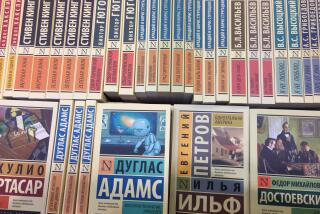Violent Incidents in 1984 Made Americans Wary : Leningrad’s Image Improving in United States
- Share via
LENINGRAD, Soviet Union — The boulevards in this city on the Neva River are alive with American fur buyers, athletes and tourists, and both Soviet officials and Western diplomats predict that 1986 will bring the biggest influx of visitors from the United States since the heyday of detente.
But officials on both sides interpret the anticipated surge in American visitors as far more significant than just a boost in tourism. They say it represents a mending of the 1984 rift between Washington and Leningrad, which was touched off by reports that the city was not safe for Americans. The warming trend, they say, amounts to a slight aperture in this “Window on the West,” originally known as St. Petersburg and built on a marsh in the early 18th Century by Peter the Great.
The signs of the trend are everywhere.
In April, Pan American World Airways is to begin twice-weekly landings at Leningrad, the first air links between the United States and the Soviet Union’s second-largest city.
The Hermitage Museum, in the heart of the city, will open a display of Impressionist paintings from Washington’s National Gallery this month, the first art show from the United States in this country in six years.
A visit here by the San Francisco Philharmonic and exchanges of ballet troupes involving American companies and the world-famous Kirov are also under discussion, according to Western diplomats here.
The general strain in U.S.-Soviet relations that followed the 1979 Soviet invasion of Afghanistan took an added twist here.
Incidents in 1984
Tension between local authorities and the small contingent of Leningrad-based U.S. diplomats mounted after incidents in the spring of 1984 in which a Marine and a U.S. diplomat were roughed up by locals.
The State Department then issued a travel warning to Americans to avoid Leningrad.
As a result, the 1983 level of 45,000 American tourists fell to 35,000 in 1984, according to Western figures.
After the warning was lifted last March, figures rose again and are still rising. This year, Western authorities say, 55,000 to 60,000 Americans are expected to visit Leningrad--a higher total than in any year since detente came to an end in 1979.
The Window on the West has also provided an outlet for a small number of Leningrad residents with spouses in the United States.
Six of the Soviet citizens who have been named by Soviet officials as eligible to join family members in the United States live in Leningrad, according to diplomatic sources here. They include Mikhail Iossel, married to Edith Luthi of Holliston, Mass., and Leonid M. Ablavsky, married to Robin Rubendust of Somerville, Mass.
In addition, Soviet officials told San Francisco Mayor Dianne Feinstein that 10 of the 80 “divided families” cases she raised during a visit here last month would be settled.
Links between Leningrad and San Francisco--a potential sister city--were strengthened during Feinstein’s three-day visit here, which was heavily publicized in the local press.
The link would be the first between a U.S. city and Leningrad, which is already involved in cultural and other exchanges with 22 foreign cities, including Manchester, England, and Milan, Italy.
San Francisco often has been compared to Leningrad since 1972, when the United States opened a consulate here and the Soviet Union opened one in San Francisco.
But, according to Western diplomatic sources here, San Francisco may pay a high political cost if it aligns with a city that has a reputation among human rights activists here and in the United States for tough treatment of Jews and dissidents.
More to Read
Sign up for Essential California
The most important California stories and recommendations in your inbox every morning.
You may occasionally receive promotional content from the Los Angeles Times.













